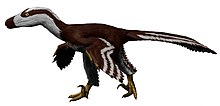Acheroraptor
| Acheroraptor | |
|---|---|

| |
| Casts of the holotype maxilla and referred dentary, National Museum of Natural History. | |
| Scientific classification | |
| Domain: | Eukaryota |
| Kingdom: | Animalia |
| Phylum: | Chordata |
| Clade: | Dinosauria |
| Clade: | Saurischia |
| Clade: | Theropoda |
| Clade: | Pennaraptora |
| Clade: | Paraves |
| Family: | †Dromaeosauridae |
| Genus: | †Acheroraptor Evans et al., 2013 |
| Type species | |
| †Acheroraptor temertyorum Evans et al., 2013
| |
Acheroraptor is an
Discovery and naming

Acheroraptor was first described and named by David C. Evans, Derek W. Larson and Philip J. Currie in
Acheroraptor is known from the
Classification

The
Evans et al. (2013) also coded the specimens of Acheroraptor (together and separately) into an updated version of the smaller, dromaeosaur-specific dataset from Longrich and Currie (2009).
| Dromaeosauridae |
| |||||||||||||||||||||||||||||||||||||||||||||||||||||||||||||||||||||||||||||||||||||||||||||||||||||||||||||||||||||
A 2022 study of eudromaeosauria reclassified Acheroraptor as a derived member of Saurornitholestinae, with Atrociraptor as its sister taxon.[2]
Paleoecology

Acheroraptor is the youngest species of dromaeosaurid, and is from the Hell Creek Formation.
Evans et al. found that Acheroraptor was the only dromaeosaurid from the Hell Creek Formation. Common teeth previously referred to

Mammals are plentiful in the Hell Creek Formation. Groups represented include
See also
References
- ^ S2CID 14978813.
- S2CID 247039404.
- .
- ^ ISBN 0520242092.
- ^ S2CID 17099603.
- ^ PMID 21914849.
- ^ PMID 24647078.
- ^ Triebold, M. (1997). "The Sandy site: Small dinosaurs from the Hell Creek Formation of South Dakota". In Wolberg, D.; Stump, E.; Rosenberg, G. (eds.). Dinofest International: Proceedings of a Symposium Sponsored by Arizona State University Academy of Natural Science. pp. 245–248.
- .
- ^ Maltese, A. (17 December 2013). "Giant Oviraptor Tracks from the Hell Creek". RMDRC paleo lab. Blogspot. Retrieved 17 December 2013.
- ISBN 9780253353580.
- PMID 21969872.
- ^ Bakker, R.T.; Sullivan, R.M.; Porter, V.; Larson, P.; Saulsbury, S.J. (2006). "Dracorex hogwartsia, n. gen., n. sp., a spiked, flat-headed pachycephalosaurid dinosaur from the Upper Cretaceous Hell Creek Formation of South Dakota". In Lucas, S.G.; Sullivan, R.M. (eds.). Late Cretaceous vertebrates from the Western Interior. New Mexico Museum of Natural History and Science Bulletin. Vol. 35. pp. 331–345.
- ^ OCLC 61160163.
- ^ S2CID 36025237.
- ^ S2CID 16724836.
